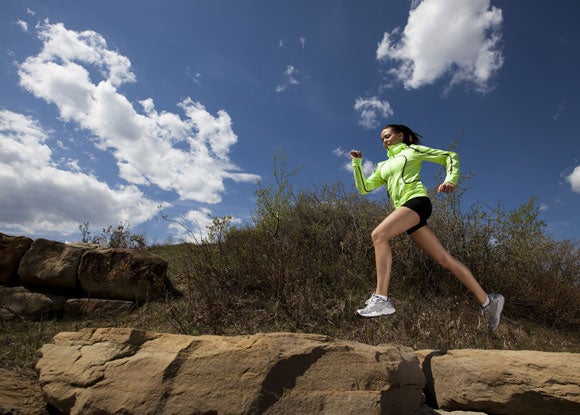Efficient Running Cadence

Photo courtesy of Shutterstock.com
Want to improve your speed and lessen the risk of injury? Challenge your intuition with these tips to increase your speed and running efficiency!
TEST TIME
Take this little test:
1. Head outside in your run gear and go for an easy 5-minute jog.
2. After completing the jog, launch into a sprint and run as fast as you can for 30 seconds.
3. Repeat steps 1 & 2, this time paying close attention to your stride length (the distance between each step) during the easy run as compared to the sprint.
4. Compare the results (for example, did your stride lengthen during your sprint?).
If you haven’t paid close attention to your stride length or run cadence, chances are this quick test resulted in a longer stride during your sprint. Don’t worry- you’re not alone! Our intuition tells us that in order to run faster, we must cover more ground or widen our gait. Often times, this results in injury due to unbalanced weight proportion and greater bone and joint impact.
In order to run faster and more efficiently, runners must work to quicken their cadence or shorten their strides. Doing so lessens the impact of running and evenly distributes weight throughout the center of the body, under the hips. Taking smaller, quicker steps also helps continue the forward motion of the body, resulting in a fluid run cycle.
MEASURE YOUR CADENCE
1. Warm-up with an easy 5 minute jog.
2. When your muscles feel warm and you’ve achieved a natural rhythm, begin counting your left leg steps for 30 seconds. Multiply the number by four to calculate your cadence or steps per minute (SPM).
CADENCE GOALS
At the 1984 Olympics, Coach Jack Daniels conducted research by counting the SPM of accomplished distance runners. Daniels found the fastest, most efficient runners achieved atleast 180 SPM. After Daniels shared his observation, the running world exploded with the new-found knowledge and many coaches pushed athletes of all abilities to run 180 SPM or faster.
More recently, scientists in the field of biomechanics agree that running with a faster cadence (or high SPM) can increase speed, though the golden rule of 180 SPM does not apply across the board. Instead, experts recommend runners measure their cadence and set a goal to increase the SPM by 5 – 10%. A 5 – 10% growth may not result in a 180 SPM number; however a runner will still experience performance enhancement and reduce the risk of injury by improving her cadence.
TOOL TIME
Being mindful of your cadence during a training session requires concentration. Until your increased SPM becomes second-nature, there are tools available to help gauge your rate:
–Run with a metronome. There’s an app for that (no, really – there are a lot of apps for that). With a quick search on your smartphone, you’ll find a variety of metronome apps available for download (some are even FREE!). Simple download one and input your goal cadence. The metronome will then beep at the set rate. Start running by trying to mimic the beeps with your steps. After the initial awkwardness, you’ll find that your feet fall into a natural rhythym with the tones.
–Musical motivation. As SPM or cadence grows in training popularity, more technology to identify the beats per minute (BPM) of a song becomes available. Check out Rock My Run or JogTunes for playlists tailored to specific BPM. Like a metronome, running to a song blasting your goal SPM beat will encourage your feet to match the cadence.